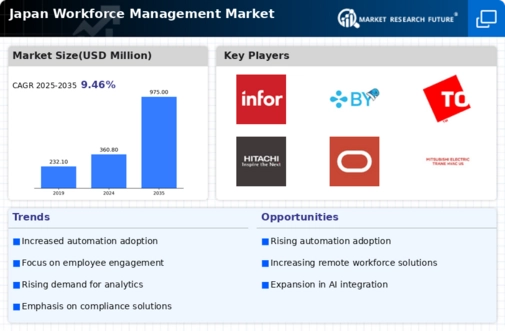Regulatory Compliance and Labor Laws
Japan's stringent labor laws and regulations significantly influence the workforce management market. Organizations must navigate complex compliance requirements, which include working hours, overtime pay, and employee rights. As the government continues to enforce these regulations, companies are compelled to adopt workforce management solutions that ensure adherence to legal standards. This necessity creates a demand for software that can automate compliance reporting and track employee hours accurately. In 2025, it is estimated that compliance-related investments will account for nearly 15% of total spending in the workforce management market. Consequently, businesses are increasingly prioritizing solutions that mitigate legal risks and enhance operational transparency.
Demographic Shifts and Aging Workforce
Japan is experiencing significant demographic changes, particularly an aging population, which poses challenges for the workforce management market. As the workforce ages, organizations must adapt their management strategies to accommodate older employees while attracting younger talent. This demographic shift necessitates flexible work arrangements and tailored training programs to enhance productivity and engagement. By 2025, it is anticipated that nearly 40% of the workforce will be over 50 years old, prompting companies to invest in workforce management solutions that address these unique needs. This trend highlights the importance of creating inclusive work environments that cater to diverse age groups, ultimately driving innovation and competitiveness.
Shift Towards Data-Driven Decision Making
The increasing emphasis on data analytics is reshaping the workforce management market in Japan. Organizations are leveraging data to make informed decisions regarding staffing, productivity, and employee engagement. By utilizing advanced analytics tools, companies can identify trends and patterns that inform workforce strategies. This data-driven approach not only enhances operational efficiency but also improves employee satisfaction and retention rates. As of 2025, it is projected that data analytics will play a crucial role in approximately 30% of workforce management initiatives. This shift indicates a growing recognition of the value of data in optimizing workforce performance and aligning human resources with business objectives.
Technological Advancements in Workforce Management
The rapid evolution of technology is a primary driver in the workforce management market. In Japan, organizations are increasingly adopting advanced software solutions that enhance operational efficiency. The integration of cloud-based platforms allows for real-time data access and analytics, which are crucial for informed decision-making. As of 2025, the market is projected to grow at a CAGR of approximately 10%, driven by the need for automation and improved workforce planning. Companies are investing in tools that facilitate scheduling, time tracking, and performance management, thereby optimizing labor costs and productivity. This trend indicates a shift towards more sophisticated workforce management systems that can adapt to the dynamic needs of businesses in Japan.
Increased Focus on Employee Engagement and Retention
Employee engagement has emerged as a critical factor influencing the workforce management market in Japan. Organizations are recognizing that engaged employees are more productive and less likely to leave, which directly impacts operational costs. As a result, companies are investing in workforce management solutions that facilitate communication, feedback, and recognition. In 2025, it is estimated that organizations will allocate approximately 20% of their workforce management budgets to initiatives aimed at enhancing employee engagement. This focus on retention strategies, such as career development programs and wellness initiatives, reflects a broader understanding of the link between employee satisfaction and organizational success.




















Leave a Comment